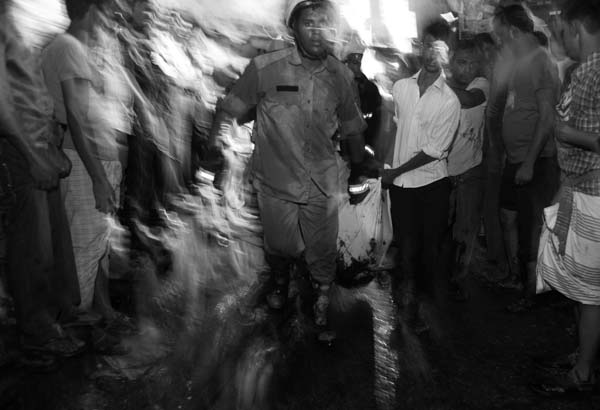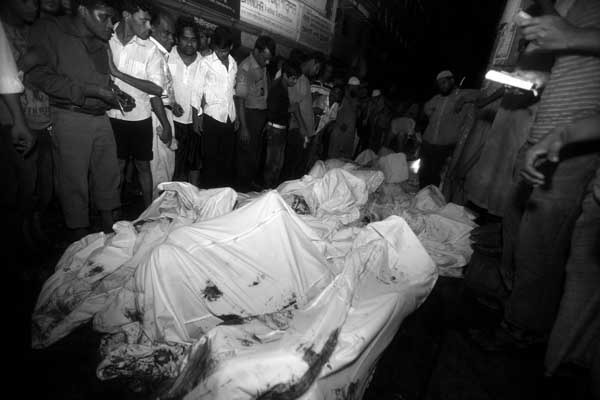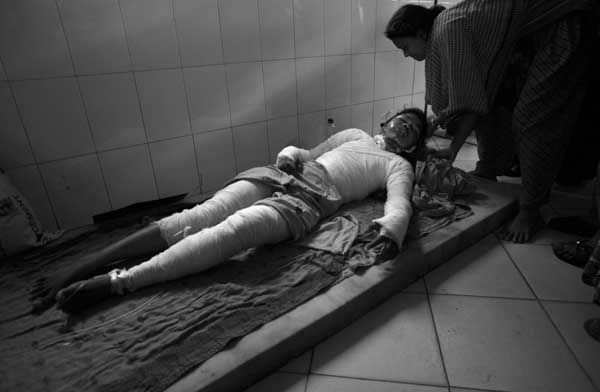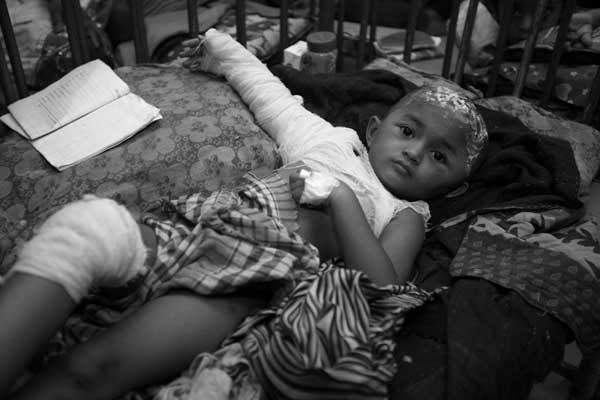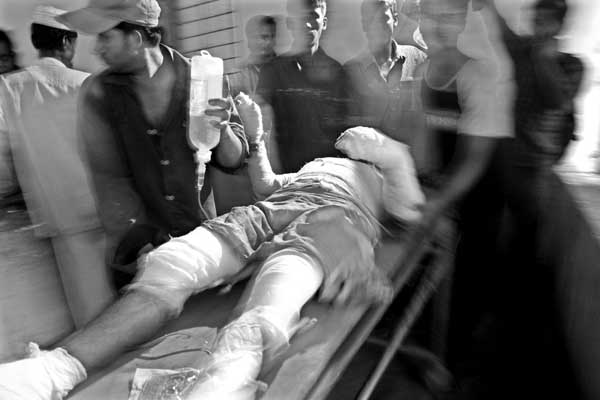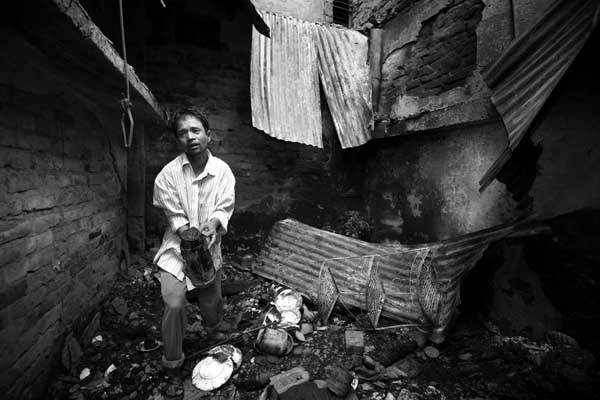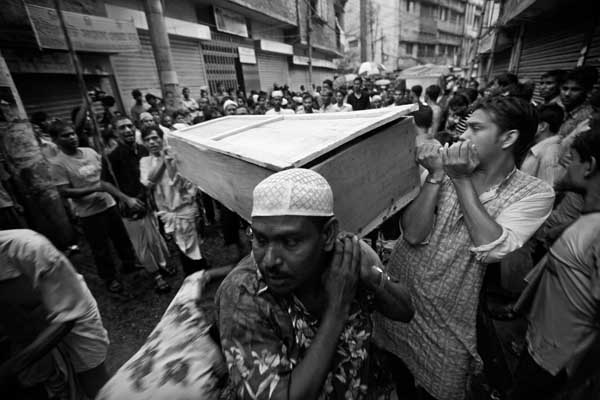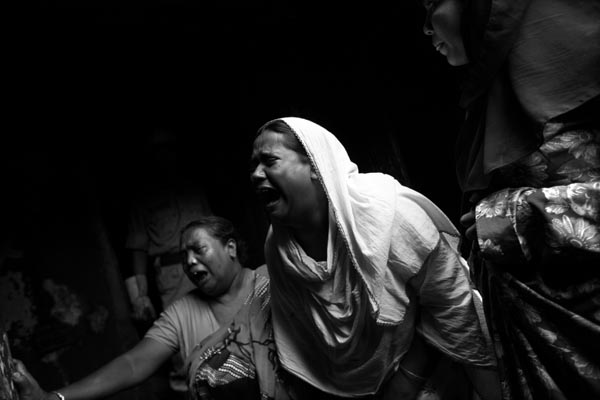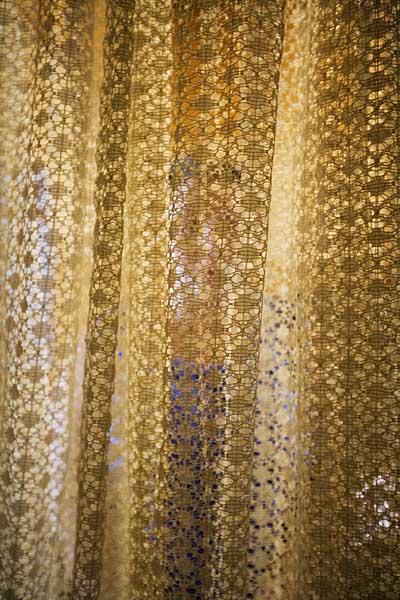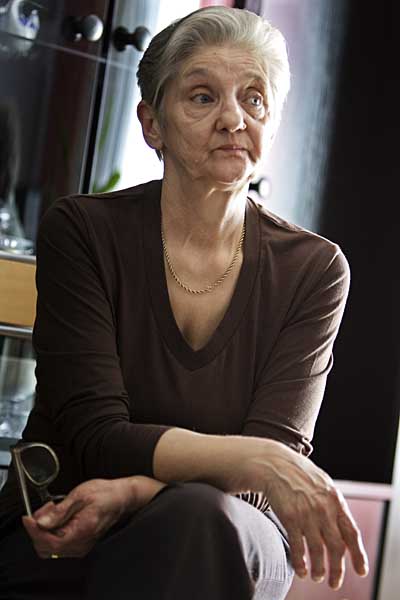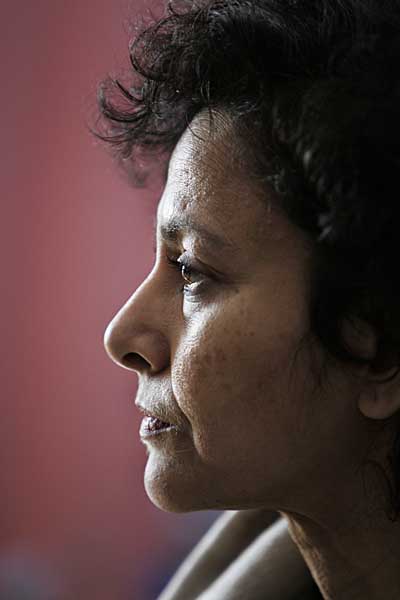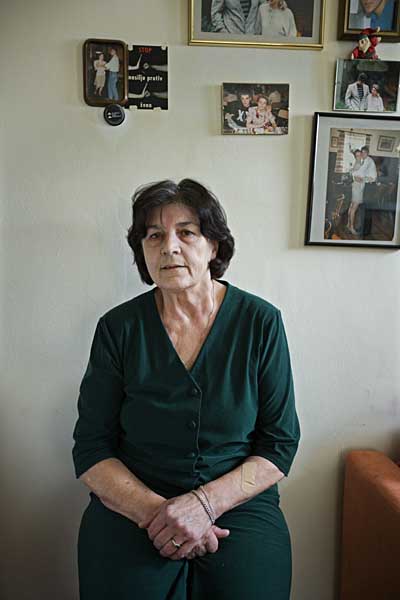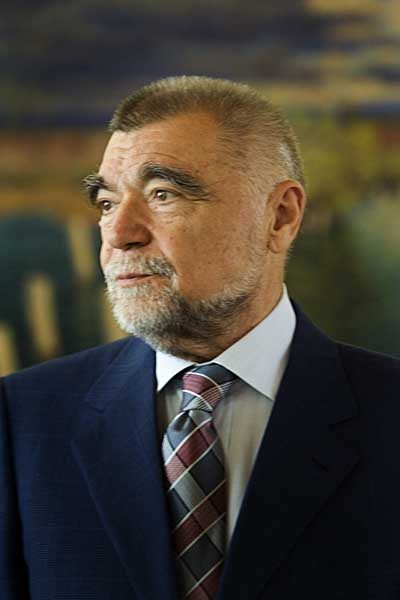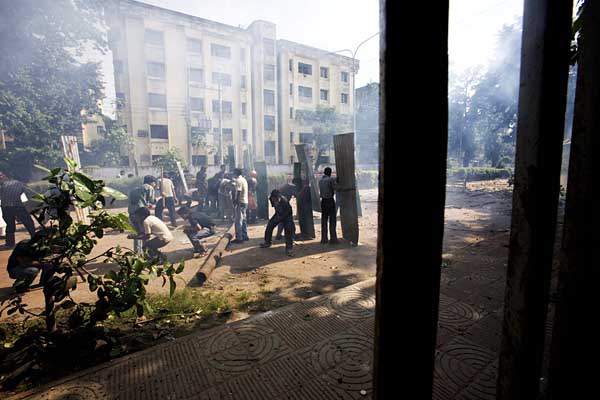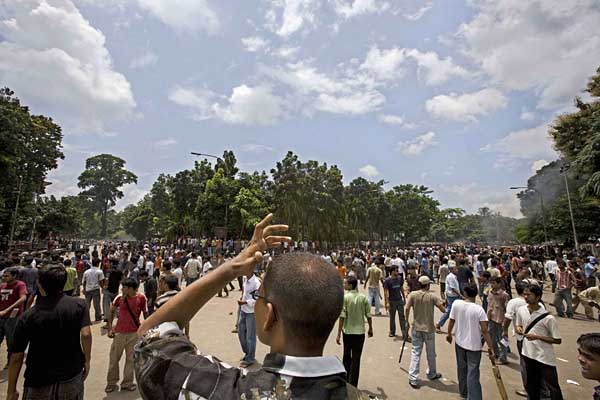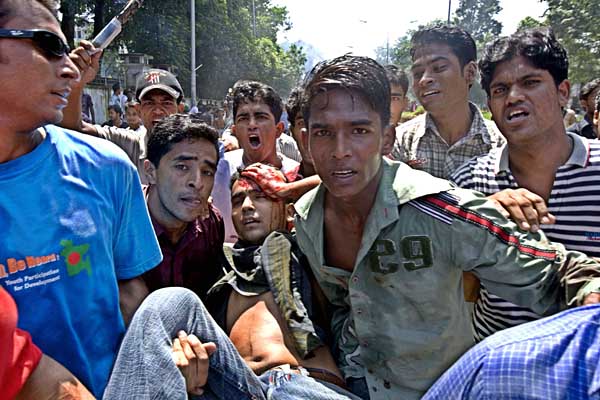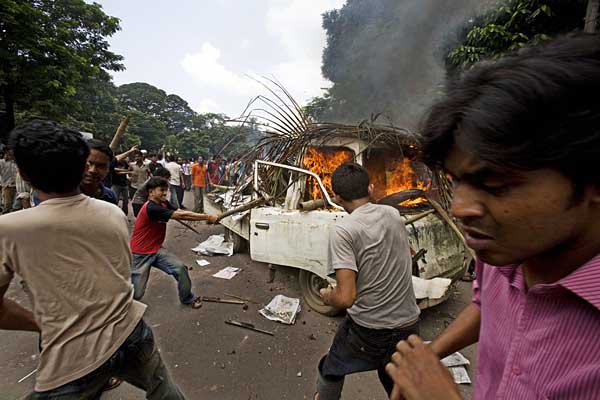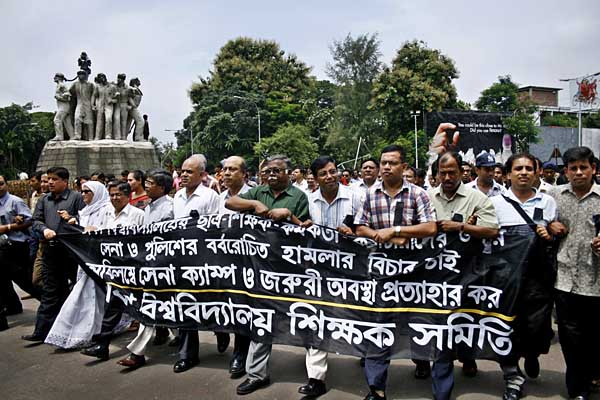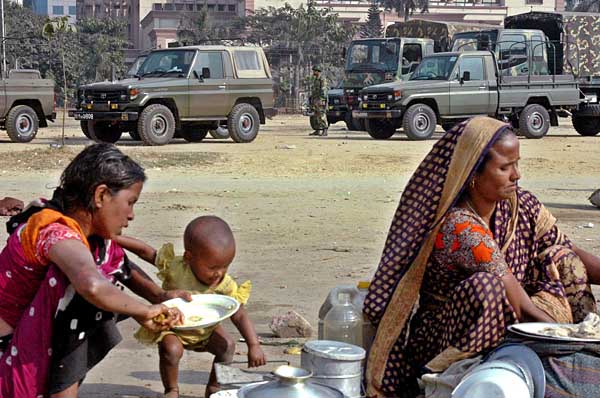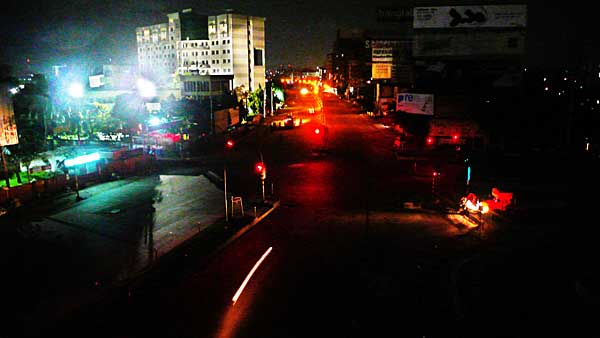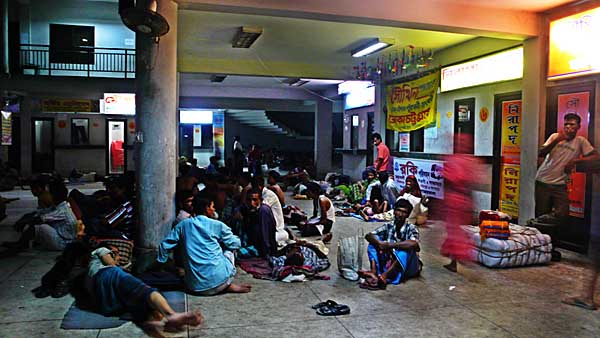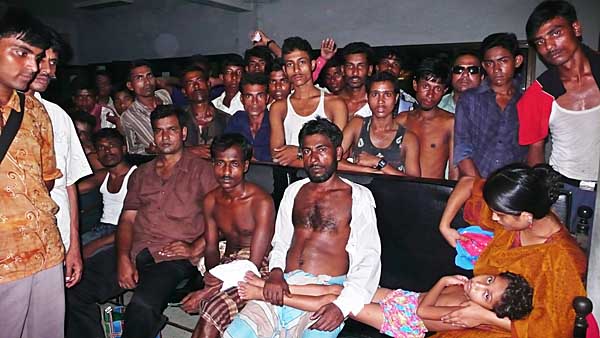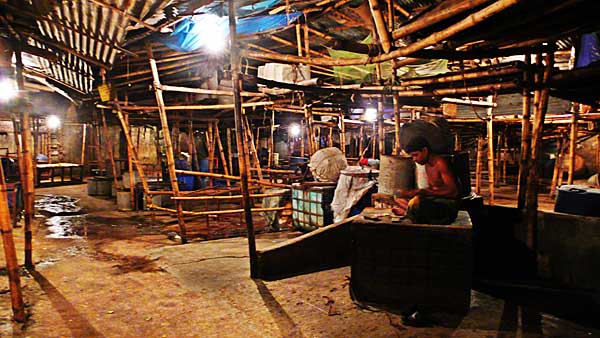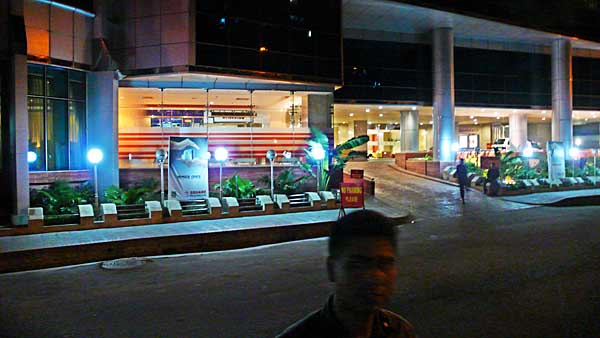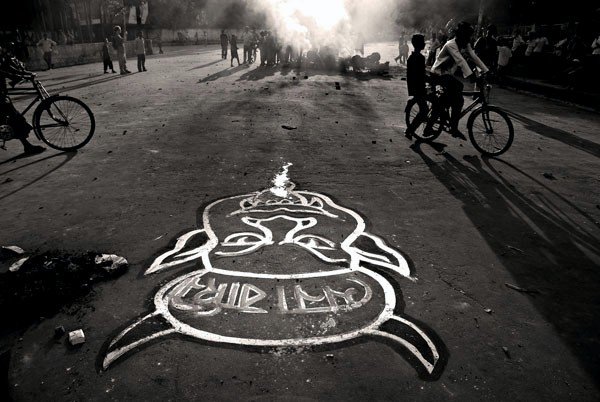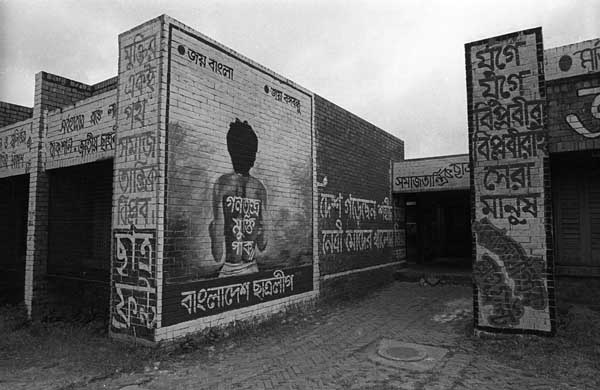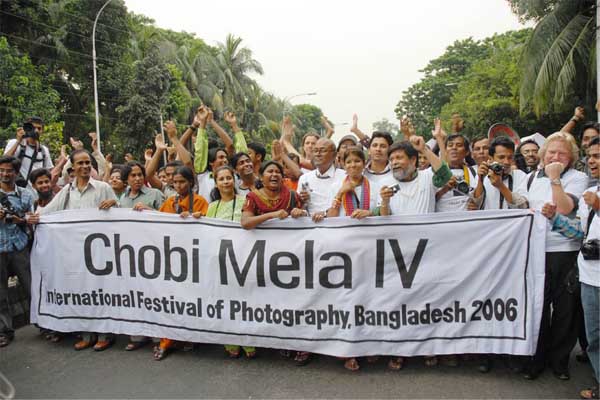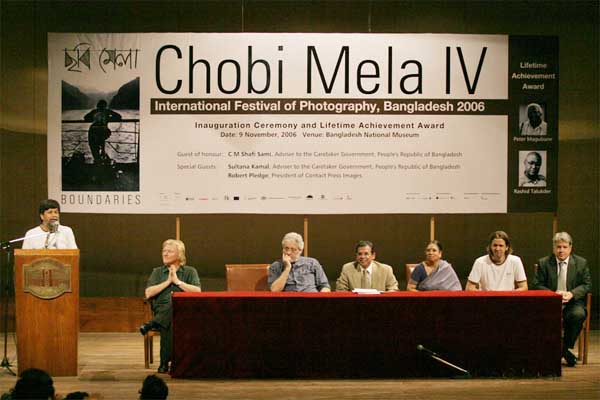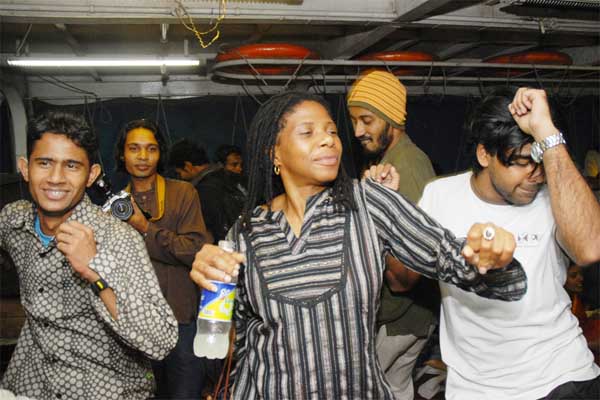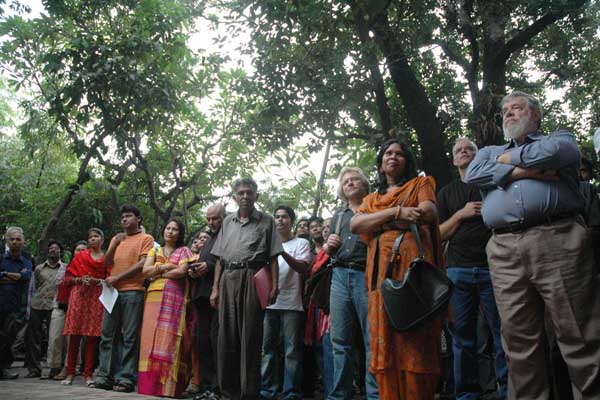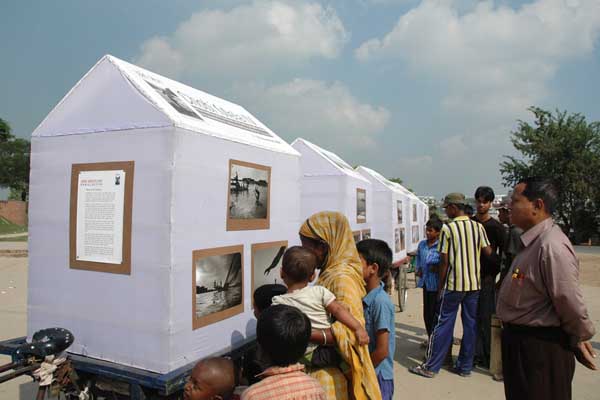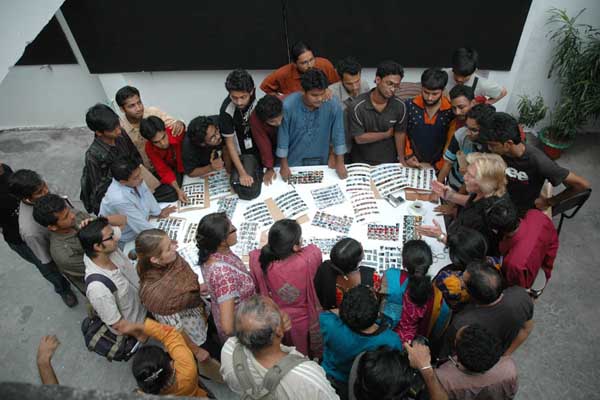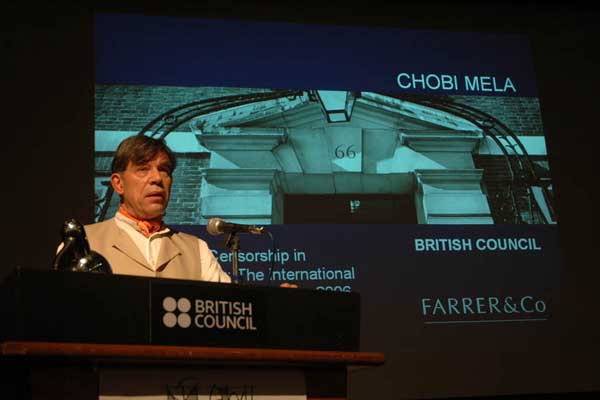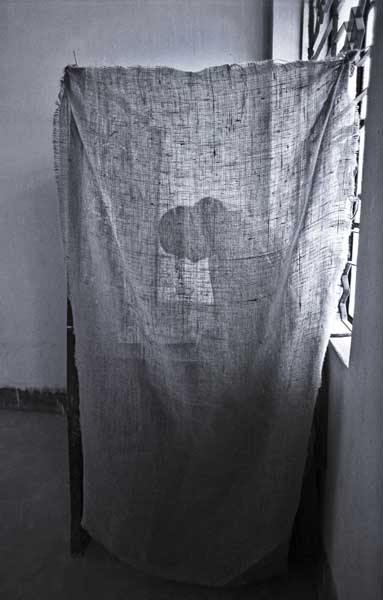
The New York Review of Books
Two photographs, taken by digital camera at Abu Ghraib prison, on the night of November 5, 2003. The first picture shows a person in a ragged black poncho-like garment standing precariously on a tiny box. Hairy legs and arms suggest that this person is a man. His head is covered in a pointed black hood, his arms are spread, and his fingertips are attached to wires sticking from the concrete wall behind him. The pose hints at a crucifixion, but the black poncho and hood also suggest a witch or a scarecrow.
The second picture shows a young woman hunched over the corpse of a man. The corpse lies in a half-unzipped black body bag filled with ice cubes wrapped in plastic. His mouth is open; white bandages cover his eyes. The young woman grins widely at the camera. She holds up the thumb of her right hand, encased in a turquoise latex glove.
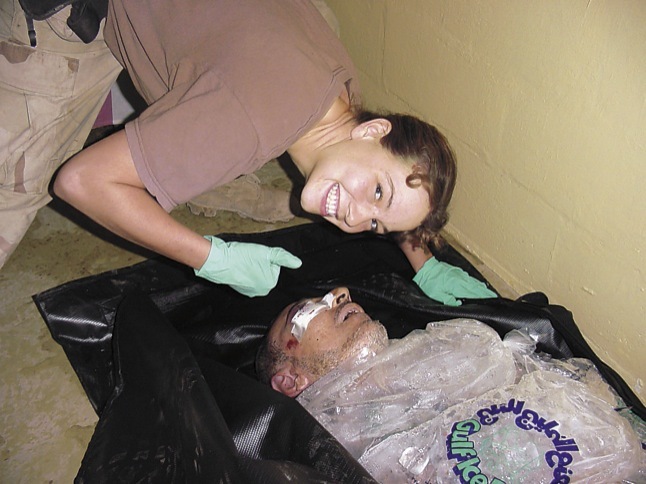
The photographs look amateurish, a crude mixture of the sinister and lighthearted. When they were published, first in The New Yorker magazine, we were provided with some background to them, but not much. The anonymous man in the first picture had been told that he would die of electric shock if he fell off the box. Hence the wires, which were in fact harmless. Information about the second picture was sketchy, but the woman seemed to be gloating over the man’s death. The bandages suggested serious violence. There were other Abu Ghraib photographs, published widely on the Internet: of terrified Iraqi prisoners, stripped of all their clothes, being assaulted and bitten by dogs (“doggie dancing”); of a naked prisoner on all fours held on a leash by a female American guard; of naked men piled up in a human pyramid; of naked men made to masturbate, or posed as though performing oral sex; of naked men wearing women’s panties on their heads, handcuffed to the bars of their cells; of naked men used as punching bags; and so on.
The photographs evoked an atmosphere of giddy brutality. The reputation of the United States, already tarnished by a bungled war, hit a new low. But interpretations of the photographs, exactly what they told us, varied according to the observer. After he was criticized for failing to apologize, President Bush said in a public statement that he was “sorry for the humiliation suffered by the Iraqi prisoners, and the humiliation suffered by their families.” But he felt “equally sorry,” he said, “that people who have been seeing those pictures didn’t understand the true nature and heart of America.” Donald Rumsfeld deplored the fact that the pictures had been shown at all, and then talked about charges of “abuse,” which, he believed, “technically is different from torture.” The word “torture” was carefully avoided by both men. President Bush, confronted much later with questions about a damning Red Cross report about the use of torture by the CIA, spelled out his view: “We don’t torture.”[1]
Susan Sontag, writing in The New York Times Magazine, had a different take on the pictures. She thought the “torture photographs” of Abu Ghraib were typical expressions of a brutalized popular American culture, coarsened by violent pornography, sadistic movies and video games, and a narcissistic compulsion to put every detail of our lives, especially our sexual lives, on record, preferably on public record. To her the Abu Ghraib photos were precisely the true nature and heart of America. She wrote:
Soldiers now pose, thumbs up, before the atrocities they commit, and send the pictures to their buddies. Secrets of private life that, formerly, you would have given anything to conceal, you now clamor to be invited on a television show to reveal. What is illustrated by these photographs is as much the culture of shamelessness as the reigning admiration for unapologetic brutality.[2]
Many liberal-minded people would have shared instinctively not only Sontag’s disgust but also her searing indictment of modern American culture. One of the merits of Errol Morris’s new documentary on the Abu Ghraib photographs, and even more of the excellent book written by Philip Gourevitch in cooperation with Morris, is that they complicate matters. What we think we see in the pictures may not be quite right. The pictures don’t show the whole story. They may even conceal more than they reveal. By interviewing most of the people who were involved in the photographic sessions, delving into their lives, their motives, their feelings, and their views, then and now, the authors assemble a picture of Abu Ghraib, the implications of which are actually more disturbing than Sontag’s cultural critique.
At first no one knew the dead man’s name. He was one of the “ghost prisoners,” brought into the “hard site” of Abu Ghraib by anonymous American interrogators, dressed in black, also known to the MPs as “ghosts.” These ghosts belonged to the OGA, Other Government Agency, which usually meant the CIA. Ghost prisoners were not formally registered before their interrogation in shower cubicles or other secluded parts of the prison. They disappeared as swiftly as they came, after the ghost interrogators were done with them. All that the MPs heard of their presence were screams in the night. If the Red Cross visited, the ghost prisoners were to be hidden away.
The man who would soon die arrived in the night before the photographs published in The New Yorker were taken, with a sandbag over his head, and nothing but a T-shirt on. MPs were told to shackle his hands to a window behind his back in “a Palestinian hanging position” (a technique allegedly used but certainly not invented by the Israelis). The man was breathing heavily. Then the MPs were dismissed. An hour or so later, they were called back in to help. The prisoner was no longer responding to questions. They hung him higher and higher, until his arms seemed at breaking point. Still no response. A splash of cold water. His hood was lifted. The MPs noticed that his face had been reduced to a bloody pulp. He had been dead for some time. The ghosts quickly left the scene. Medics were called in to clean up the mess, bandages were put over his puffed-up eyes, and the corpse was zipped into an ice-filled body bag and left in a shower room until it could be removed. The officer in charge of the MPs at Abu Ghraib, Captain Christopher Brinson, declared that the man had died of a heart attack.
Meanwhile, in the same prison block, another torment was taking place. Another nameless prisoner had been brought in, suspected of having killed an agent from the US Army’s Criminal Investigative Division (CID). He refused to divulge his name, so he was handed over to Specialist Charles “Chuck” Graner, an army reservist. Graner, a hulking mustachioed figure, seen laughing at the misery of Iraqi prisoners in many Abu Ghraib pictures, was not trained as an interrogator; nor did he have more than the vaguest idea of the rules and conventions that are supposed to guide interrogations. A corrections officer in civilian life, Graner enjoyed a “bad boy” reputation, with a taste for sinister pranks and an eye for the girls. He should never have been put in charge of terror suspects. He did not even have the security clearance to be a military policeman with custody over prisoners.
Nonetheless, Graner was put in charge of the nameless prisoner and told by CID agent Ricardo Romero to “make his life a living hell for the next three days and find out his name.” Graner did his best, aided by Sergeant Ivan Frederick and other members of their Maryland reserve unit who happened to be around and were equally untrained in interrogation work. The prisoner was stripped of his clothes, yelled at, made to crawl on the floor, deprived of sleep, forced to stand on a tiny box, hooked up to wires sticking from the wall and told he would die if he so much as moved. This last game lasted for about fifteen minutes, long enough for Graner to take his photographs.
Morris didn’t manage to interview Graner. He is still in a military prison. But other witnesses of what happened that night, such as Specialist Sabrina Harman, claim that not much harm was done to the prisoner they nicknamed “Gilligan.” She said that he ended up laughing at the Americans, and actually became a popular guy of sorts, being given the privilege of sweeping up the prison cells. “He was just a funny, funny guy,” she said. “If you were going to take someone home, I definitely would have taken him.”
Sabrina Harman also happens to be the young woman in the second picture, hunched over the corpse. Like Graner, she worked as a guard on the night shift at Abu Ghraib. Harman is described by other interviewees in Morris’s film as a sweet girl who, in the words of Sergeant Hydrue Joyner, “would not hurt a fly. If there’s a fly on the floor and you go to step on it, she will stop you.” The reason she joined the army was to pay for college. Her dream was to be a cop, like her father and brother. Not just a cop, but a forensic photographer. She loved taking pictures, with a special interest in death and decay. Another prison colleague, Sergeant Javal Davis, said: “She would not let you step on an ant. But if it dies, she’d want to know how it died.”
So when water started seeping out of the locked shower cell, and she and Graner uncovered the dead man in his body bag, her first instinct was to take pictures. She told Morris and Gourevitch that she
kind of realized right away that there was no way he died of a heart attack, because of all the cuts and blood coming out of his nose. You don’t think your commander’s going to lie to you about something. It made my trust go down, that’s for sure.
This is when Graner asked her to pose with the body. Harman adopted the pose she always did in photos, with her friends, with prisoners, in the morgue, and now in the shower: she grinned and stuck her thumb up.
Later, she returned to the same place alone, curious to find out more. She took off the gauze over the dead man’s eyes and “just started taking photos of everything I saw that was wrong, every little bruise and cut.” She realized how badly the man had been beaten up:
It looked like somebody had either butt-stocked him or really got him good, or hit him against the wall…. I just wanted to document everything I saw. That was the reason I took photos. It was to prove to pretty much anybody who looked at this guy, Hey, I was just lied to. This guy did not die of a heart attack. Look at all these other existing injuries that they tried to cover up.
In her interview with Morris, Harman looks rather impressive: intelligent, articulate, plausible. The interviews are actually more like monologues, for with rare exceptions Morris’s questions are never heard. His genius is to get people to talk, and talk, and talk, whether it is Robert McNamara in The Fog of War or Sabrina Harman in Standard Operating Procedure. The fact that he paid some of his interviewees for their time has been held against Morris by some critics. It seems of little importance. There is no reason to believe that cash changed their stories. If only the film had stuck to the interviews. Alas, they are spliced together with gimmicky visual reenactments of the scenes described in words, which take away from the stark air of authenticity. But perhaps that is Morris’s point. Authenticity is always elusive. Nothing can be totally trusted, not words, and certainly not images, so you might as well reimagine them.
But I think we are meant to believe that Harman is telling the truth. Her letters from Abu Ghraib to her lesbian partner, Kelly, suggest as much. On October 20, 2003, she wrote about a prisoner nicknamed “the taxicab driver,” naked, handcuffed backward to the bars of his cell, with his underwear over his face:
He looked like Jesus Christ. At first I had to laugh so I went on and grabbed the camera and took a picture. One of the guys took my asp and started “poking” at his dick. Again I thought, okay that’s funny then it hit me, that’s a form of molestation. You can’t do that. I took more pictures now to “record” what is going on.
Two pictures, then. The first one, of Gilligan and the electric wires, was analyzed by Brent Pack, a special forensic expert for the CID. After much thought, he concluded:
I see that as somebody that’s being put into a stress position. I’m looking at it and thinking, they don’t look like they’re real electrical wires. Standard operating procedure?that’s all it is.
He was technically right. A memo drawn up by the Pentagon’s general counsel, William J. Haynes, on November 27, 2002, recommending authorization of interrogation techniques in Category II?which included humiliation, sensory deprivation, and stress positions?was formally approved by the secretary of defense. Donald Rumsfeld even scribbled his famous quip at the bottom of this memo, stating: “However, I stand for 8?10 hours a day. Why is standing limited to 4 hours? D.R.”[3]
And yet this picture, more than any other, including the ones featuring attack dogs and wounded naked bodies, became the most notorious, an icon of American barbarism, the torture picture par excellence, perhaps because, as Gourevitch writes, it left so much to the imagination. That, and its evocation of the crucifixion, Christ at Abu Ghraib. And Sabrina Harman? She was sentenced to six months in prison, a reduction in rank to private, a forfeiture of all pay and allowances, and a bad conduct discharge. None of the men who were responsible for her subject’s death were ever prosecuted. No one above the rank of sergeant was even tried. As Morris said in an interview to promote his film, Harman and her friends caught in the photographs
were punished for embarrassing the military, for embarrassing the administration. One central irony: Sabrina Harman was threatened with prosecution for taking pictures of a man who had been killed by the CIA. She had nothing whatsoever to do with the killing, she merely photographed the corpse. But without her photographs we would know nothing of this crime.
It was just another death of a ghost delivered by ghosts.
2.
Morris has been faulted for not pointing his finger more directly at people more senior than Harman, Graner, Frederick, or Lynndie England, Graner’s girlfriend at the time, who held the naked prisoner on a leash. But this is missing the point of the film. For it is not about Washington politics or administration lawyers, or at least not directly, but about a particular kind of concealment, the way photographs which seem to tell one story actually turn out to hide a much bigger story. Compared to what was really happening at Abu Ghraib, where men were tortured to death in hidden cells, where children were incarcerated with thousands of other prisoners, most of them blameless civilians, exposed to daily mortar attacks, living in unspeakable conditions of filth and squalor, where there was no way out even for men who had been declared innocent, where unarmed prisoners were shot dead by nervous guards?compared to all that, the photograph of Gilligan was just fun and games.
The first thing human beings do when the unspeakable becomes standard operating procedure is to change the words. Even the Nazis, who never seemed to have been unduly bothered by what they did, invented new words, usually of a cold bureaucratic nature, to conceal their crimes: “special treatment” and so on. In public, the US policy toward “security detainees” or “unlawful combatants,” to whom, according to White House and Pentagon lawyers, the Geneva Conventions did not apply, was couched in the kind of language favored by Vice President Dick Cheney: “We need to make certain that we have not tied the hands, if you will, of our intelligence communities in terms of accomplishing their mission.”
The phrase “the gloves are coming off” gained currency. As in an e-mail, quoted by Gourevitch, sent to MI unit commanders in Iraq by Captain William Ponce of the Human Intelligence Effects Coordination Cell: “The gloves are coming off gentlemen regarding these detainees. Col. Boltz”? Colonel Steven Boltz, the deputy MI commander in Iraq?”has made it clear that we want these individuals broken.” The likes of Harman, Graner, England, and Frederick were at the very bottom of the chain of command. They were told to “soften up” the prisoners, to make their lives hell. They should “treat the prisoners like dogs,” in the words of Major General Geoffrey Miller, commander of the prison and interrogation camp at Guant?namo Bay. He said this before the photographs were taken, during a visit to Abu Ghraib, where he felt the prisoners were treated too well. His methods, honed at Guant?namo, were soon adopted. One of Morris’s (or Gourevitch’s) more arresting ideas is that the photographs of the treatment meted out to the prisoners are evidence that the people who were ordered to take their gloves off, if you will, had not entirely lost their moral way. Gourevitch writes:
Even as they sank into a routine of depravity, they showed by their picture taking that they did not accept it as normal. They never fully got with the program. Is it not to their credit that they were profoundly demoralized by their service in the netherworld?
Credit is perhaps not the mot juste. Nazis who took pictures of naked women lined up in front of their own mass graves might not have considered the scene quite normal either, but this does not mean that they were not with the program. Heinrich Himmler was well aware that what he was asking from his SS men was not normal. That is why he told them to steel themselves against any feelings of humanity that would hamper them in their necessary task.
That Harman, for one, was often disgusted with what she saw at Abu Ghraib is indeed clear from her letters to her partner, Kelly. And even Graner, the baddest of the bad apples, was apparently taken aback when he was told by “Big Steve” Stefanowicz, a contract civilian interrogator, just how roughly prisoners were to be “broken.” Graner was reminded of 24, the popular television series, starring Kiefer Sutherland, about the necessity of using any means, including torture, to stop terrorists. Graner claims that he told Big Steve: “We don’t do that stuff, that’s all TV stuff.” Graner was surely unaware that 24 had actually been discussed in all seriousness at brainstorming sessions at Guant?namo led by the staff judge advocate, Lieutenant Colonel Diane Beaver. She recalled the mounting excitement among her male colleagues, including men from the CIA and the DIA, as different interrogation techniques were being bandied about. She told Philippe Sands, author of Torture Team: “You could almost see their dicks getting hard as they got new ideas.”
That was in Guant?namo, where ideas were hatched, noted on legal pads, recorded in memos, debated in air-conditioned offices. Now back to Graner in the filth, noise, and menace of constant violence in Abu Ghraib prison. As the authors point out, there is a kind of pornographic quality to many of the pictures which would indicate that Susan Sontag’s cultural critique was not entirely off beam.
The deliberate use of women, for example, in the humiliation of Arab prisoners is striking. Graner may have asked his girlfriend, Lynndie England, to pose for a picture holding a prisoner on a leash. This might have given him, and possibly her, an erotic frisson. And Sabrina Harman, too, is seen to have been a grinning accomplice in several of Graner’s pranks with naked prisoners. That is why she ended up being convicted. But in fact these games?some clearly staged for the camera as cruel photo-ops?were also part of the program. The women’s panties, the nudity in front of women, the poking of the genitals, the enforced simulation of sexual acts, were all part of the program. Graner was told in writing by his commander, Captain Brinson, that he was “doing a fine job.” He was told: “Continue to perform at this level and it will help us succeed at our overall mission.”
The MPs at Abu Ghraib, as Gourevitch rightly observes, knew little about Middle Eastern culture, but they were given “cultural awareness” training at Fort Lee, before being flown out to Iraq. They were told that sexual humiliation was the most effective way to “soften up” Arab detainees. A person does not have to be corrupted by the popular culture deplored by Susan Sontag to be vulnerable to feelings of pleasure when the sexual humiliation of others is officially sanctioned, even encouraged. Graner’s real sin for the administration was not that he went too far (which, measured by any moral yardstick, of course he did), but that he took pleasure in what should have been a grim job. As Dick Cheney said: “It is a mean, nasty, dangerous, dirty business out there, and we have to operate in that arena.” Hard dicks should have been kept strictly out of sight, under conference tables. But Graner turned the dirty business into his own pornographic fantasies; and what is worse, he recorded them on film, for all the world to see.
Lynndie England played a walk-on part in these fantasies. She loved Graner. She would have done anything he wanted. That was her tragedy. England was sentenced to three years in a military prison for maltreating detainees. “All I did was what I was told to do,” she said, in the oldest defense of men and women landed with the dirty work. “I didn’t make the war. I can’t end the war. I mean, photographs can’t just make or change a war.”
Harman, too, acted out her fantasies, of being a forensic photographer, of recording death. As a result, she made the program public, and forced the president of the greatest power on earth to issue a public apology. As Morris says, in his interview: “Under a different set of circumstances, you could imagine Sabrina winning a Pulitzer Prize for photography.” Instead, she was charged not only with dereliction of duty and maltreatment, but with destroying government property and “altering evidence,” by removing the bandages from the dead man’s eyes. She told Morris: “When he died, they cleaned him all up, and then stuck the bandages on. So it’s not really altering evidence. They had already done that for me.” Since her pictures revealed the truth of this statement, these particular charges were eventually dropped.
Both Morris’s film and the book based on it by Gourevitch are devastating, even without going into detail about the complicity, or indeed responsibility, of top officials in the Bush administration. The photographs embarrassed the United States, to be sure. But for the US government, this embarrassment might have actually helped to keep far greater embarrassments from emerging into public view. Preoccupied by the pornography of Abu Ghraib, we have been distracted from the torturing and the killing that was never recorded on film and from finding out who the actual killers were. Moral condemnation of the bad apples turned out to be a highly useful alibi. By looking like a bunch of gloating thugs, “Chuck” Graner, Ivan Frederick, et al. made the law-yers, bureaucrats, and politicians who made, or rather unmade, the rules?William J. Haynes, Alberto Gonzales, David S. Addington, Jay Bybee, John Yoo, Douglas J. Feith, Donald Rumsfeld, and Dick Cheney?look almost respectable.
And Gilligan, by the way, was probably not the man anyone thought he was after all, but an innocent who happened to be in the wrong place at the wrong time. Just like up to 90 percent of the men and boys locked up in Abu Ghraib.
